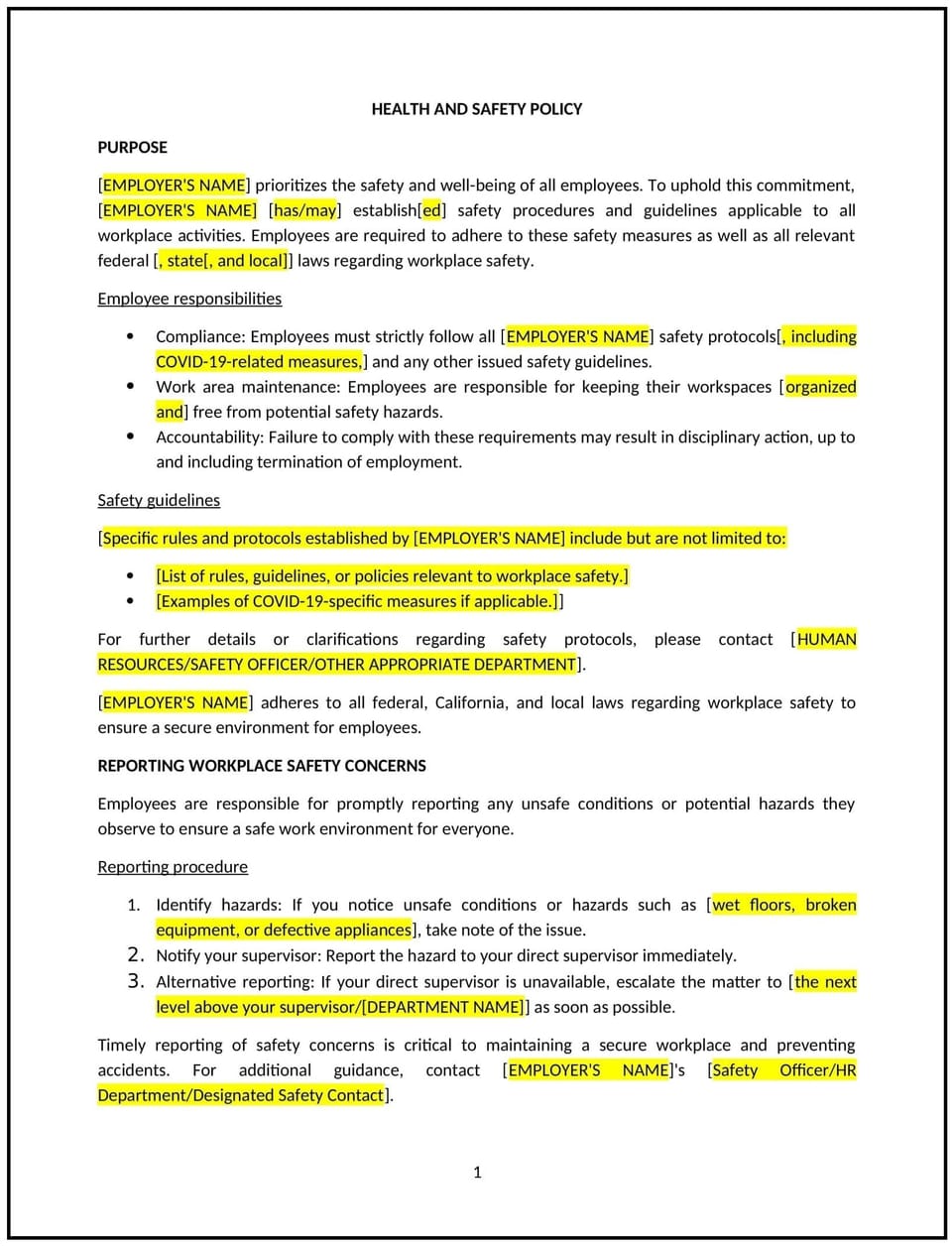Health and safety policy (California): Free template

Health and safety policy (California)
In California, a health and safety policy provides businesses with guidelines to create and maintain a safe working environment for employees, customers, and visitors. This policy supports compliance with California Occupational Safety and Health Administration (Cal/OSHA) regulations and reflects the business’s commitment to preventing workplace injuries and illnesses.
This policy outlines responsibilities, procedures for identifying and mitigating risks, and processes for responding to incidents. By implementing this policy, California businesses can promote employee well-being and minimize operational disruptions.
How to use this health and safety policy (California)
- Define safety responsibilities: Assign roles for implementing and monitoring safety procedures, such as safety officers or team leads.
- Identify risks: Outline processes for conducting regular hazard assessments to identify and address workplace safety concerns.
- Establish safety protocols: Provide clear instructions for using equipment, handling hazardous materials, and maintaining a safe environment.
- Communicate incident procedures: Detail the steps for reporting, documenting, and responding to workplace accidents or injuries.
- Train employees: Offer regular safety training to ensure employees understand their responsibilities and know how to prevent and respond to hazards.
Benefits of using this health and safety policy (California)
This policy offers several advantages for California businesses:
- Supports compliance: Reflects Cal/OSHA regulations and promotes adherence to California-specific safety standards.
- Enhances employee well-being: Demonstrates the business’s commitment to protecting employees’ health and safety.
- Reduces risks: Helps prevent workplace injuries, illnesses, and accidents through proactive measures.
- Promotes accountability: Clarifies roles and expectations for maintaining a safe workplace.
- Minimizes disruptions: Reduces operational downtime caused by accidents or safety violations.
Tips for using this health and safety policy (California)
- Reflect California-specific laws: Address state requirements for workplace safety under Cal/OSHA regulations, including industry-specific standards.
- Conduct regular audits: Schedule routine inspections to identify hazards and ensure compliance with safety protocols.
- Provide accessible resources: Make safety equipment, manuals, and emergency contact information readily available to employees.
- Encourage reporting: Create a culture where employees feel comfortable reporting hazards or concerns without fear of retaliation.
- Review regularly: Update the policy to reflect changes in California laws, workplace conditions, or industry practices.
Q: How does this policy benefit the business?
A: This policy supports compliance with Cal/OSHA regulations, reduces workplace risks, and demonstrates the business’s commitment to safety.
Q: What steps should employees take to report a safety concern?
A: Employees should report hazards or concerns to their manager or the designated safety officer through the channels outlined in the policy.
Q: How does this policy support compliance with California laws?
A: The policy reflects Cal/OSHA requirements, ensuring the business implements lawful and effective safety practices.
Q: What types of safety training should the business provide?
A: Training should cover hazard identification, emergency procedures, equipment use, and any industry-specific safety protocols.
Q: How can the business monitor compliance with this policy?
A: The business can conduct regular audits, maintain safety records, and review incident reports to ensure adherence to safety standards.
This article contains general legal information and does not contain legal advice. Cobrief is not a law firm or a substitute for an attorney or law firm. The law is complex and changes often. For legal advice, please ask a lawyer.


